

Der Blaue Reiter. Cover of Der Blaue Reiter almanac, c.1912 Der Blaue Reiter (The Blue Rider) was a group of artists united in rejection of the Neue Künstlervereinigung München in Munich, Germany.
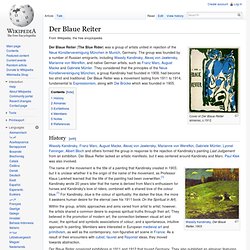
Paul Klee. Paul Klee (German pronunciation: [paʊ̯l ˈkleː]; 18 December 1879 – 29 June 1940) was a painter born in Münchenbuchsee, Switzerland, and is considered to be a German-Swiss.

[a] His highly individual style was influenced by movements in art that included expressionism, cubism, and surrealism. He was also a student of orientalism.[1] Klee was a natural draftsman who experimented with and eventually got deep into color theory, writing about it extensively; his lectures Writings on Form and Design Theory (Schriften zur Form und Gestaltungslehre), published in English as the Paul Klee Notebooks, are held to be as important for modern art as Leonardo da Vinci's A Treatise on Painting for the Renaissance.[2][3][4] He and his colleague, the Russian painter Wassily Kandinsky, both taught at the German Bauhaus school of art, design and architecture. Die Brücke. Fritz Bleyl poster for the first Die Brücke show in 1906 Die Brücke manifesto 1906 Die Brücke (The Bridge) was a group of German expressionist artists formed in Dresden in 1905, after which the Brücke Museum in Berlin was named.

Founding members were Fritz Bleyl, Erich Heckel, Ernst Ludwig Kirchner and Karl Schmidt-Rottluff. Later members were Emil Nolde, Max Pechstein and Otto Mueller. The seminal group had a major impact on the evolution of modern art in the 20th century and the creation of expressionism.[1] Die Brücke is sometimes compared to the Fauves. Georg Baselitz. Georg Baselitz (born 23 January 1938) is a German painter who studied in the former East Germany, before moving to what was then the country of West Germany.
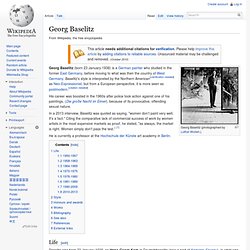
Baselitz's style is interpreted by the Northern American[clarification needed] as Neo-Expressionist, but from a European perspective, it is more seen as postmodern. Francis Bacon. Francis Bacon in his studio Francis Bacon (28 October 1909 – 28 April 1992) was an Irish-born British figurative painter known for his bold, graphic and emotionally raw imagery.[1] His painterly but abstracted figures typically appear isolated in glass or steel geometrical cages set against flat, nondescript backgrounds.

Bacon began painting during his early 20s and worked only sporadically until his mid-30s. Lucian Freud. Lucian Michael Freud, OM, CH (/ˈlʊ.siː.ən ˈfrɔɪd/; 8 December 1922 – 20 July 2011)[1] was a German-born British painter.
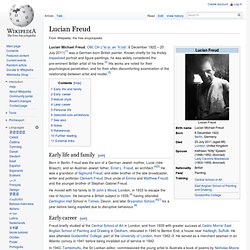
Known chiefly for his thickly impastoed portrait and figure paintings, he was widely considered the pre-eminent British artist of his time.[2] His works are noted for their psychological penetration, and for their often discomforting examination of the relationship between artist and model.[3] Early life and family[edit] Born in Berlin, Freud was the son of a German Jewish mother, Lucie (née Brasch), and an Austrian Jewish father, Ernst L.
Freud, an architect.[4][5] He was a grandson of Sigmund Freud, and elder brother of the late broadcaster, writer and politician Clement Freud (thus uncle of Emma and Matthew Freud) and the younger brother of Stephan Gabriel Freud. Tableaux de Lucian Freud. Éternels Éclairs La Biographie Tableaux sélectionnés : Des droits d'auteurs protègent les oeuvres ici présentes ; en cas de réclamation des ayants droit celles-ci seraient immédiatement retirées.
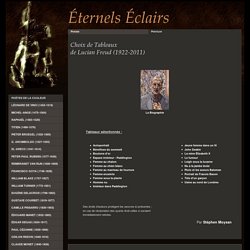
Par Stéphen Moysan. Tableaux de Francis Bacon. Copyright Francis Bacon, Study for Head of George Dyer, 1969.

" Pitié pour la viande! Il n'y a pas de doute, la viande est l'objet le plus haut de la pitié de Bacon, son seul objet de pitié, sa pitié d'Anglo-Irlandais. Et sur ce point, c'est comme pour Soutine, avec son immense pitié de Juif. La viande n'est pas une chair morte, elle a gardé toutes les souffrances et pris sur soi toutes les couleurs de la chair vive. Edvard Munch. Un article de Wikipédia, l'encyclopédie libre.
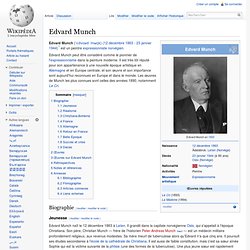
Edvard Munch Edvard Munch en 1933 Œuvres réputées Edvard Munch (ˈɛdvɑʁd ˈmʉŋk) (12 décembre 1863 - 23 janvier 1944)[1] est un peintre expressionniste norvégien. Edvard Munch peut être considéré comme le pionnier de l'expressionnisme dans la peinture moderne. Tableaux d'Edvard Munch. Éternels Éclairs La Biographie Des droits d'auteurs protègent les oeuvres ici présentes ; en cas de réclamation des ayants droit celles-ci seraient immédiatement retirées.

Par Stéphen Moysan 1. Otto Dix. Wilhelm Heinrich Otto Dix (German: [ˈvɪlhɛlm ˈhaɪnʁiç ˈɔto ˈdɪks]; 2 December 1891 – 25 July 1969) was a German painter and printmaker, noted for his ruthless and harshly realistic depictions of Weimar society and the brutality of war. Along with George Grosz, he is widely considered one of the most important artists of the Neue Sachlichkeit. Biography[edit] Early life and education[edit] Otto Dix House in Gera.
The artist's birthplace opened as a museum in 1991. Tableaux d'Otto Dix. Exercices d'improvisation théatrale. Expressionism. Expressionism was a modernist movement, initially in poetry and painting, originating in Germany at the beginning of the 20th century. Its typical trait is to present the world solely from a subjective perspective, distorting it radically for emotional effect in order to evoke moods or ideas.[1][2] Expressionist artists sought to express meaning[3] or emotional experience rather than physical reality.[3][4] Origin of the term[edit]